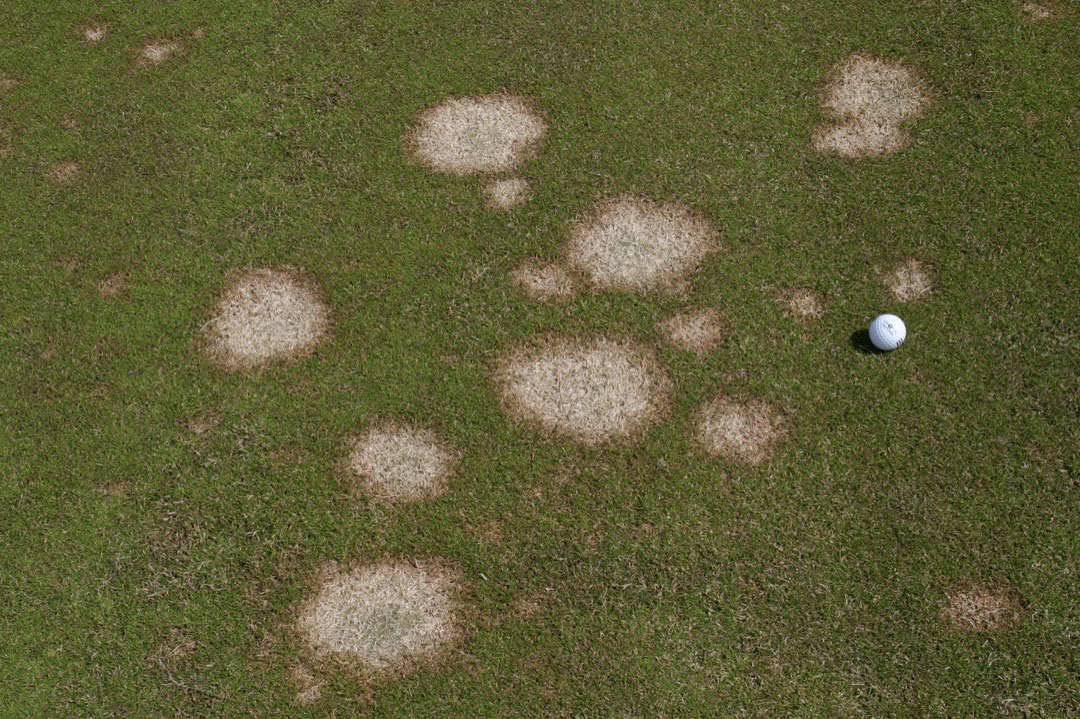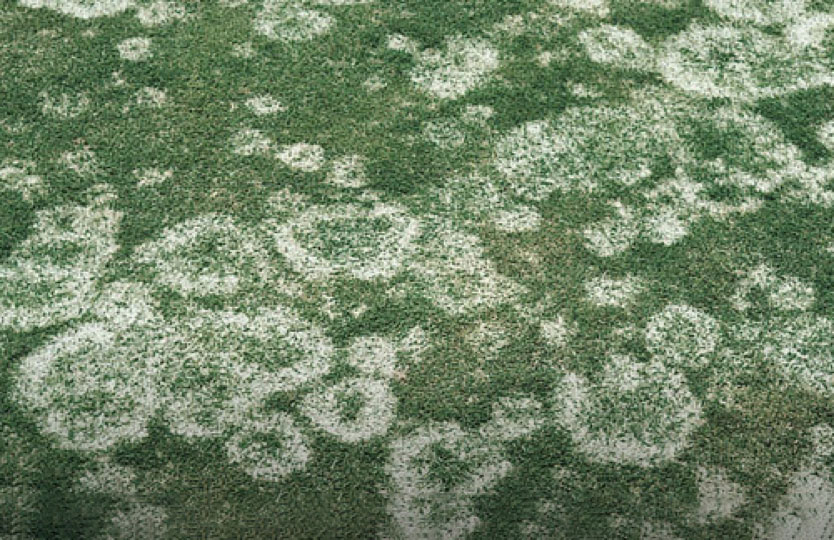Winter turfgrass diseases are often associated with melting snow or cold, wet periods. Diseases can attack bluegrasses, fescues, and ryegrasses, but bentgrasses are most susceptible. Two diseases, Grey Snow Mold and Pink Snow Mold, may occur independently or side-by-side. It is necessary to distinguish between these two diseases, as different fungicides may be used to control each.
Identifying Pink Snow Mold
Pink Snow Mold is a disease that may affect all cool-season turfgrasses but appears to be most damaging to creeping bentgrass and annual bluegrass on golf courses. The disease is caused by the fungal pathogen Microdochium nivale. This pathogen blights leaves but does not affect roots and crowns.

Pink snow mold infection results in 6”-12” circular patches.
On short-mown golf turf, Pink Snow Mold can present as well-defined, circular patch clusters on creeping bentgrass greens. Streaks of off-colored turf that follow the green’s surface drainage patterns may also appear during the spring. White-pink mycelium may be observed on infected leaf blades during cool, wet conditions. Patches of dead, matted leaf blades also occur on taller mown turf but often lack a clearly circular pattern. The temperatures that favor pink mold infection and its spread range from 32˚F–50˚F. Pink mold is often very active through mid-spring.
Identifying Grey Snow Mold
Gray Snow Mold affects all cool-season turfgrass species in areas with extended snow cover periods. It can occur in areas without prolonged snow cover, but here it typically only causes cosmetic damage. Either of two Typhula species can cause the disease: Typhula incarnata and Typhula ishikariensis. T. incarnata outbreaks are normally less severe, and infected patches tend to recover more quickly in the spring. T. ishikariensis infections may progress down into the crown, resulting in plant death or more severe and lasting damage.

Gray snow mold
The Gray Snow Mold fungi are active in a very narrow range of low temperatures (31˚F–36˚F). If snow cover exists for less than 45 days, then damage and symptom expression will be mild or negligible. If snow cover exists for 45–90 days, then moderate snow mold can be expected. If snow cover occurs for more than 90 days, then the risk of severe turf damage is high.
Strategies for managing snow mold
Various cultural methods can reduce the development of Pink Snow Mold. Avoid late fall applications of fertilizer that would stimulate succulent growth. Such growth is very susceptible to infection. Also, continue to mow turf as long as it continues to grow in the fall, and avoid compacting snow over the turf.
Fungicide applications should be made in late autumn/early winter just before permanent snow cover is expected. If possible, apply fungicide during a mid-winter thaw. For putting greens, green surrounds, and tees, a variety of fungicide mixtures that include two or three different products can be quite effective. A DMI fungicide should be one component of the mixture. Other successful components include dicarboximides, strobilurins, and fludioxanil. Combination products on the market have also been shown to be very effective. Call or check your local turf extension office for what is available in your area.
Where snow mold has caused damage, rake the matted grass to encourage new spring growth. If reseeding areas where the disease has been a problem, use disease-resistant turfgrass varieties.




